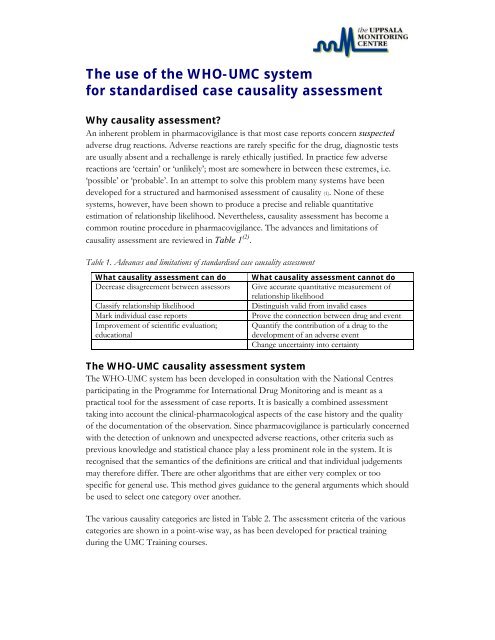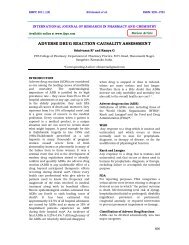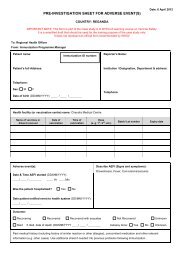24734
Create successful ePaper yourself
Turn your PDF publications into a flip-book with our unique Google optimized e-Paper software.
The use of the WHO-UMC system<br />
for standardised case causality assessment<br />
Why causality assessment?<br />
An inherent problem in pharmacovigilance is that most case reports concern suspected<br />
adverse drug reactions. Adverse reactions are rarely specific for the drug, diagnostic tests<br />
are usually absent and a rechallenge is rarely ethically justified. In practice few adverse<br />
reactions are ‘certain’ or ‘unlikely’; most are somewhere in between these extremes, i.e.<br />
‘possible’ or ‘probable’. In an attempt to solve this problem many systems have been<br />
developed for a structured and harmonised assessment of causality (1). None of these<br />
systems, however, have been shown to produce a precise and reliable quantitative<br />
estimation of relationship likelihood. Nevertheless, causality assessment has become a<br />
common routine procedure in pharmacovigilance. The advances and limitations of<br />
causality assessment are reviewed in Table 1 (2) .<br />
Table 1. Advances and limitations of standardised case causality assessment<br />
What causality assessment can do<br />
Decrease disagreement between assessors<br />
Classify relationship likelihood<br />
Mark individual case reports<br />
Improvement of scientific evaluation;<br />
educational<br />
What causality assessment cannot do<br />
Give accurate quantitative measurement of<br />
relationship likelihood<br />
Distinguish valid from invalid cases<br />
Prove the connection between drug and event<br />
Quantify the contribution of a drug to the<br />
development of an adverse event<br />
Change uncertainty into certainty<br />
The WHO-UMC causality assessment system<br />
The WHO-UMC system has been developed in consultation with the National Centres<br />
participating in the Programme for International Drug Monitoring and is meant as a<br />
practical tool for the assessment of case reports. It is basically a combined assessment<br />
taking into account the clinical-pharmacological aspects of the case history and the quality<br />
of the documentation of the observation. Since pharmacovigilance is particularly concerned<br />
with the detection of unknown and unexpected adverse reactions, other criteria such as<br />
previous knowledge and statistical chance play a less prominent role in the system. It is<br />
recognised that the semantics of the definitions are critical and that individual judgements<br />
may therefore differ. There are other algorithms that are either very complex or too<br />
specific for general use. This method gives guidance to the general arguments which should<br />
be used to select one category over another.<br />
The various causality categories are listed in Table 2. The assessment criteria of the various<br />
categories are shown in a point-wise way, as has been developed for practical training<br />
during the UMC Training courses.
Table 2. WHO-UMC Causality Categories<br />
Causality term<br />
Certain<br />
Probable/<br />
Likely<br />
Possible<br />
Unlikely<br />
Conditional/<br />
Unclassified<br />
Unassessable/<br />
Unclassifiable<br />
Assessment criteria*<br />
• Event or laboratory test abnormality, with plausible time<br />
relationship to drug intake<br />
• Cannot be explained by disease or other drugs<br />
• Response to withdrawal plausible (pharmacologically,<br />
pathologically)<br />
• Event definitive pharmacologically or phenomenologically (i.e. an<br />
objective and specific medical disorder or a recognised<br />
pharmacological phenomenon)<br />
• Rechallenge satisfactory, if necessary<br />
• Event or laboratory test abnormality, with reasonable time<br />
relationship to drug intake<br />
• Unlikely to be attributed to disease or other drugs<br />
• Response to withdrawal clinically reasonable<br />
• Rechallenge not required<br />
• Event or laboratory test abnormality, with reasonable time<br />
relationship to drug intake<br />
• Could also be explained by disease or other drugs<br />
• Information on drug withdrawal may be lacking or unclear<br />
• Event or laboratory test abnormality, with a time to drug intake<br />
that makes a relationship improbable (but not impossible)<br />
• Disease or other drugs provide plausible explanations<br />
• Event or laboratory test abnormality<br />
• More data for proper assessment needed, or<br />
• Additional data under examination<br />
• Report suggesting an adverse reaction<br />
• Cannot be judged because information is insufficient or<br />
contradictory<br />
• Data cannot be supplemented or verified<br />
*All points should be reasonably complied with<br />
The use of the WHO-UMC system<br />
To illustrate how the system works, we suggest to first making a comparison of the criteria<br />
and wording of ‘Probable’ and Certain’. First of all there is one more criterion in the<br />
category ‘Certain’, the fourth: ‘Event definitive pharmacologically or phenomenologically’,<br />
i.e. an objective and specific medical disorder or a recognised pharmacological<br />
phenomenon (for instance ‘grey baby syndrome’ and chloramphenicol, or anaphylaxis<br />
immediately after the administration of a drug that had been given previously). This means<br />
that any other event is automatically excluded and can never qualify for ‘Certain’ (even in<br />
the case of a positive rechallenge observation). For ‘Certain’, rechallenge information with a<br />
satisfactory outcome is requested (i.e. what has happened when the drug was first stopped
and later on resumed), unless the evidence in the report is already convincing without a reexposure.<br />
For ‘Probable’, on the other hand, a rechallenge is not required. To qualify as ‘Certain’ the<br />
interval between the start of the drug and the onset of the event must be ‘plausible’; this<br />
means that there is in sufficient detail a positive argument in support of the view that the<br />
drug is causally involved, pharmacologically or pathologically. For ‘Probable’ the time<br />
relationship should be ‘reasonable’; this is a more neutral term covering everything that is<br />
not unreasonable. Also, with regard to the second criterion, ‘alternative causes’, the<br />
wording is different in ‘Probable’. For ‘Certain’ the occurrence of the event cannot be<br />
explained by any disease the patient is known to have or any other drug taken. For<br />
‘Probable’, on the other hand, the event is ‘unlikely’ to be attributable to another cause.<br />
Also the dechallenge situations (i.e. what happened after stopping) are different. In a<br />
‘Certain’ case report, the course of events constitutes a positive argument in favour of<br />
holding the suspected drug responsible, in pharmacological or pathological respects,<br />
whereas in a ‘Probable’ case it is sufficient if it is ‘clinically reasonable’ (i.e. not<br />
unreasonable).<br />
The essential distinctions between ‘Probable’ and ‘Possible’ are that in the latter case there<br />
may be another equally likely explanation for the event and/or there is no information or<br />
uncertainty with regard to what has happened after stopping.<br />
The criteria that may render the connection ‘Unlikely’ are firstly the time relationship is<br />
improbable (with the knowledge at the time), and/or another explanation is more likely.<br />
The term ‘Unclassified/Conditional’ is of a preliminary nature and is appropriate when, for<br />
a proper assessment, there is more data needed and such data are being sought, or are<br />
already under examination. Finally when the information in a report is incomplete or<br />
contradictory and cannot be complemented or verified, the verdict is ‘Unclassifiable’.<br />
Since by far the most frequent categories in case reports are ‘Possible’ and ‘Probable’, the<br />
usual approach to using the system is to choose one of these categories (depending on the<br />
impression of the assessor) and to test if the various criteria fit with the content of the case<br />
report. If the report seems stronger one can go one step ‘higher’ (e.g. from ‘Possible’ to<br />
‘Probable’), if the evidence seems weaker one should try a ‘lower’ category. To see if that<br />
category is the right one or if it does again not seem to fit, the next adjacent term is tried.<br />
For drug-drug interactions the WHO-UMC system can be used by assessing the actor drug,<br />
which influences the kinetics or dynamics of the other drug (which has usually been taken<br />
over a longer period), in the medical context of the patient.
How does it work?<br />
How the WHO-UMC causality assessment system can be used will be illustrated with the<br />
aid of a few real-life case reports. These will be made available on the UMC website in the<br />
near future.<br />
1. Meyboom RHB, Royer RJ. Causality Classification in Pharmacovigilance Centres in the European<br />
Community. Pharmacoepidemiology and Drug Safety 1992; 1:87-97.<br />
2. Meyboom RHB. Causal or Casual? The Role of Causality Assessment in Pharmacovigilance. Drug Safety<br />
17(6): 374-389, 1997.<br />
3. Edwards IR, Biriell C. Harmonisation in Pharmacovigilance. Drug Safety 10(2): 93-102, 1994.
Summary description of Causality Assessment<br />
Term Description Comment<br />
Certian<br />
A clinical event, including<br />
laboratory test abnormality,<br />
occurring in a plausible time<br />
relationship to drug<br />
administration, and which<br />
cannot be explained by<br />
concurrent disease or other<br />
drugs or chemicals. The<br />
response to withdrawal of the<br />
drug (dechallenge) should be<br />
clinically plausible. The event<br />
must be definitive<br />
pharmacologically or<br />
phenomenologically, using a<br />
satisfactory rechallenge<br />
procedure if necessary.<br />
It is recognized that this stringent definition<br />
will lead to very few reports meeting the<br />
criteria, but this is useful because of the<br />
special value of such reports. It is considered<br />
that time relationships between drug<br />
administration and the onset and course of<br />
the adverse event are important in causality<br />
analysis. So also is the consideration of<br />
confounding features, but due weight must<br />
placed on the known pharmacological and<br />
other characteristics of the drug product<br />
being considered. Sometimes the clinical<br />
phenomena described will also be sufficiently<br />
specific to allow a confident causality<br />
assessment in the absence of confounding<br />
features and with appropriate time<br />
relationships, e.g. penicillin anaphylaxis.<br />
Probable/ Likely<br />
A clinical event, including<br />
laboratory test abnormality,<br />
with a reasonable time<br />
sequence to administration of<br />
the drug, unlikely to be<br />
attributed to concurrent<br />
disease or other drugs or<br />
chemicals, and which follows<br />
a clinically reasonable<br />
response on withdrawal<br />
(dechallenge). Rechallenge<br />
information is not required to<br />
fulfil this definition.<br />
This definition has less stringent wording than<br />
for "certain" and does not necessitate prior<br />
knowledge of drug characteristics or clinical<br />
adverse reaction phenomena. As stated no<br />
rechallenge information is needed, but<br />
confounding drug administration underlying<br />
disease must be absent.<br />
Possible<br />
A clinical event, including<br />
laboratory test abnormality,<br />
with a reasonable time<br />
sequence to administration of<br />
the drug, but which could also<br />
be explained by concurrent<br />
disease or other drugs or<br />
chemicals. Information on<br />
drug withdrawal may be<br />
lacking or unclear.<br />
This is the definition to be used when drug<br />
causality is one of other possible causes for<br />
the described clinical event.<br />
Unlikely<br />
A clinical event, including<br />
laboratory test abnormality,<br />
with a temporal relationship to<br />
drug administration which<br />
makes a causal relationship<br />
improbable, and in which<br />
other drugs, chemicals or<br />
This definition is intended to be used when<br />
the exclusion of drug causality of a clinical<br />
event seems most plausible.
underlying disease provide<br />
plausible explanations.<br />
Conditional/<br />
Unclassified<br />
A clinical event, including<br />
laboratory test abnormality,<br />
reported as an adverse<br />
reaction, about which more<br />
data is essential for a proper<br />
assessment or the additional<br />
data are under examination.<br />
Unassessible/<br />
Unclassifiable<br />
A report suggesting an<br />
adverse reaction which cannot<br />
be judged because<br />
information is insufficient or<br />
contradictory, and which<br />
cannot be supplemented or<br />
verified.






